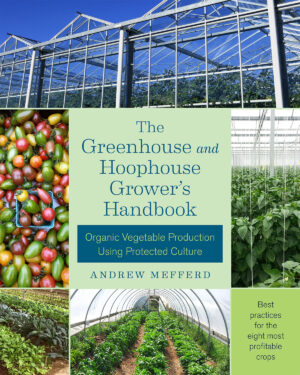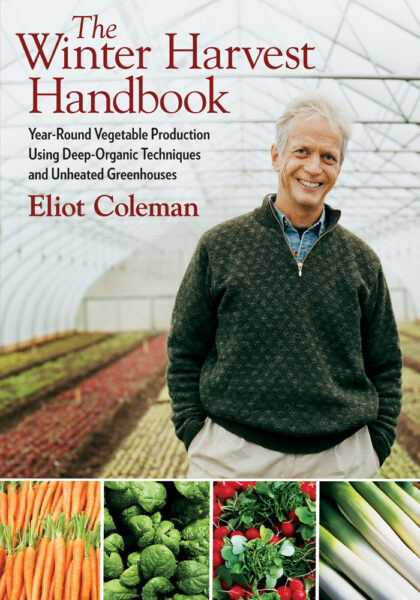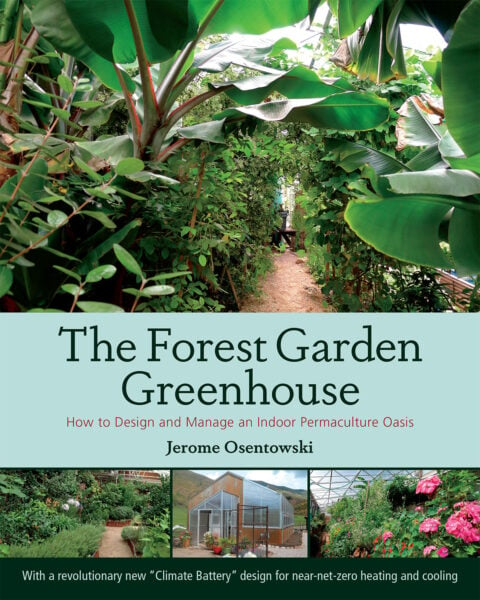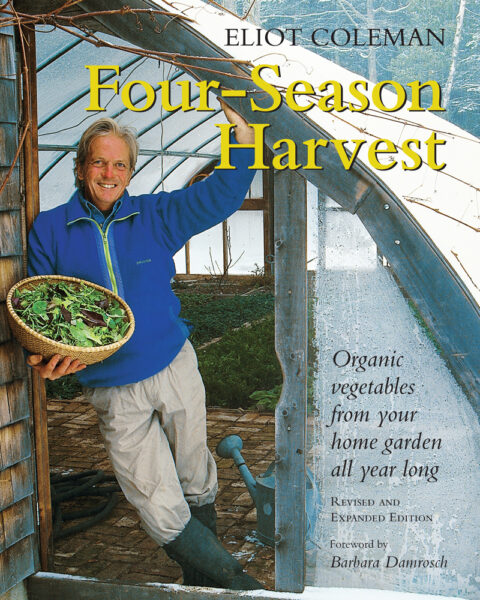A Guide to Pruning Protected Crops
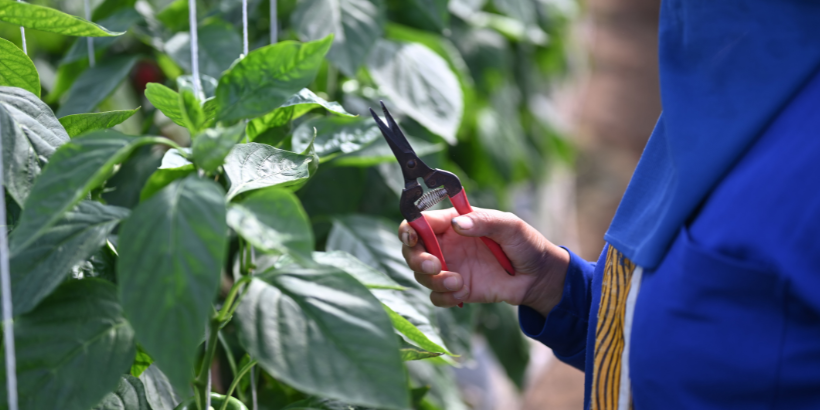
Pruning is essential for keeping protected crops healthy & balanced through the winter months. Keep reading for some helpful tips on pruning greenhouse and hoophouse plants!
The following is an excerpt from The Greenhouse and Hoophouse Grower’s Handbook by Andrew Mefferd. It has been adapted for the web.
Unless otherwise noted, all photographs copyright © 2017 by Andrew Mefferd.
Pruning Protected Crops
Though commonly practiced on all the vining/fruiting crops in protected agriculture, the goals and strategies for pruning are often misunderstood.
The best way to define pruning for protected agriculture is as a technique used to limit the amount and type of growth in order to keep plants balanced. Balanced plants will be more productive and healthier, with more predictable yields than those of unbalanced plants.
Understanding Plant Balance
Plant balance is best understood by considering what it means for a plant to be unbalanced. All of the vining crops in this book form a sucker at each node. If left to its own devices, a plant would develop a new vine at every single leaf.
Consider that every sucker would then begin producing a sucker itself at every node, and the number of heads would start to become problematic.
If a plant were allowed to develop an unlimited number of heads, its finite amount of energy would be divided among so many heads and fruits that growth and ripening would slow considerably.
I have seen this happen in indeterminate basket-weave tomato production, where ripening is noticeably slower and fruit size is smaller. With wide spacing this might not be as much of a problem, but when planted tightly in protected culture, unpruned indeterminate plants will branch out and compete with one another.
Pruning: What Does It Mean?
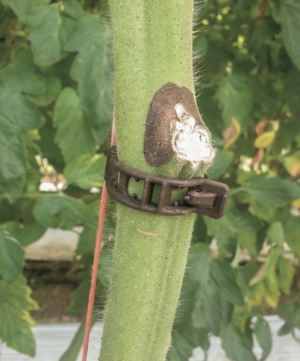
Figure 6.7. Botrytis moving into the plant through a pruning wound. Note the trellis clip that was correctly placed below the leaf before it was pruned off.
Pruning is one of the techniques that allows growers to crowd as many plants as possible into a finite area, by limiting each plant to the minimum amount of space it needs.
Pruning not only conserves space by preventing vines from branching out, but it also makes a plant more open and permits light and air to flow through the canopy.
This results in a minimal amount of yield reduction due to shading and disease. Fruit on pruned plants sizes up and ripens more quickly than on unpruned plants.
And all crops that are kept pruned are easier to harvest, because you don’t have to hunt through as much foliage to locate the fruit.
Changing Plants for Balance
Pruning allows you to change the plant to balance it to its ideal size.
For example, to grow a weak tomato variety over a long season, you might want to limit plants of that variety to only one vine, to focus all their energy up through the one stem, and hopefully keep it vigorous over the whole season.
If you grew the same weak variety grafted to a vigorous rootstock, you might be able to grow with two heads instead of one.
Growing indeterminate tomatoes unpruned in a basket weave is usually only possible in arid climates; in humid areas, the foliage is so dense that moisture builds up inside the plants’ canopy, which leaves them prone to foliar diseases.
Basics of Pruning
For specifics on how to prune each species, see the individual crop chapters. No matter what crop you are working on, though, it’s always best to cut whatever part of the plant you’re removing back to a living stem. Anytime you cut off a plant part and leave a stub, the stub may rot back into the stem and infect the rest of the plant.
Morning is a good time to prune, especially if you prune by snapping with your hands. Plants are more turgid in the morning and may snap more easily than in the afternoon, when they become more flexible.
When pruning is done in the morning, plants have the rest of the day for wounds to dry out, which will help them heal without infection. You can then spend the afternoon trellising, because the plants are more flexible when they are transpiring more, and easier to work on without breaking.
Pruning Suckers
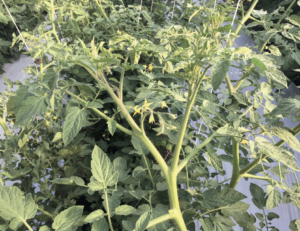
Figure 6.8. This tomato plant was not suckered on time, so the sucker is now as big as and competing with the main stem. You can tell the main stem is on the left because it has the flower cluster on it. The sucker to the right has grown out of the node of the leaf below the flower cluster.
Pruning goes hand in hand with trellising as a technique to get plants to grow the way you want them to.
In addition to opening up the plant to facilitate light transmission and airflow, it keeps the amount of foliage and fruit balanced, which will keep plant growth and yield consistent.
This may not sound like a huge issue, until you have a ton of fruit to sell one week but only half a ton the next.
When you can’t get rid of all of it the first week, and then don’t have enough the second, you will find yourself wishing you had picked three-quarters of a ton both weeks instead.
Pruning Leaves
There are times when you will want to remove some mature leaves from most of the fruiting crops. With tomatoes and eggplant, this is regularly done below the fruit to increase airflow.
Increasing airflow will reduce the amount of disease and help fruits to ripen more quickly by keeping them warmer.
Older leaves can be removed without detriment to the plant because they are in the shade and don’t contribute much to photosynthesis.
Pruning Flowering/Fruiting Clusters
All fruiting crops are prone to setting more fruit than they can mature. Pruning flowering or fruiting clusters is done with all fruiting crops at some point to put the amount of fruit set in balance with the amount of fruit the plant can actually support.
I have occasionally seen growers plant a sprawling crop of cucumbers in a hoophouse or screen house. But they could get a lot more out of the same size structure, and get a lot more cucumber plants into it, if they put in a little more labor in the form of trellising.
It is so much easier to harvest cucumbers that are held off the ground than to bend over and hunt through the leaves.
Trellising requires an up-front investment of time in order to make jobs down the road, like harvesting and pruning, go faster. It goes hand in hand with pruning to get the plants to grow the way you want them to. It’s also an investment in plant health and clean, marketable fruit.
Recommended Reads
Recent Articles
Garlic mustard: while known as “invasive,” this plant can be consumed in its entirety and has great nutritional value. Plus, the garlic-flavor is a perfect addition to any recipe that calls for mustard! The following are excerpts from Beyond the War on Invasive Species by Tao Orion and The Wild Wisdom of Weeds by Katrina…
Read MoreEveryone loves a refreshing, fermented, nutritious drink…even your garden! Take your fermentation skills out of the kitchen and into the garden by brewing fermented plant juice. The following is an excerpt from The Regenerative Grower’s Guide to Garden Amendments by Nigel Palmer. It has been adapted for the web. How to Make Fermented Plant Juice Fermented…
Read MoreWant to see your crops thrive this upcoming growing season? The key is in soil fertility and health. Spend time maintaining your soil’s health to guarantee bigger and better crops come harvest time! The following is an excerpt from No-Till Intensive Vegetable Culture by Bryan O’Hara. It has been adapted for the web. What Is Soil Fertility?…
Read MoreMany know the effects of catnip on our feline friends, but few realize that catnip has medicinal effects for humans. From stomach aches to reducing fevers, catnip is a versatile herb with many benefits. The next time you grow this plant for your cat you may end up taking a few cuttings for yourself! The…
Read MoreIt’s time to take control of your seeds and become a plant breeder! Saving your seed allows you to grow and best traditional & regional varieties, and develop more of your own. The following excerpt is from Breed Your Own Vegetable Varieties by Carol Deppe. It has been adapted for the web. Becoming A Plant…
Read More

